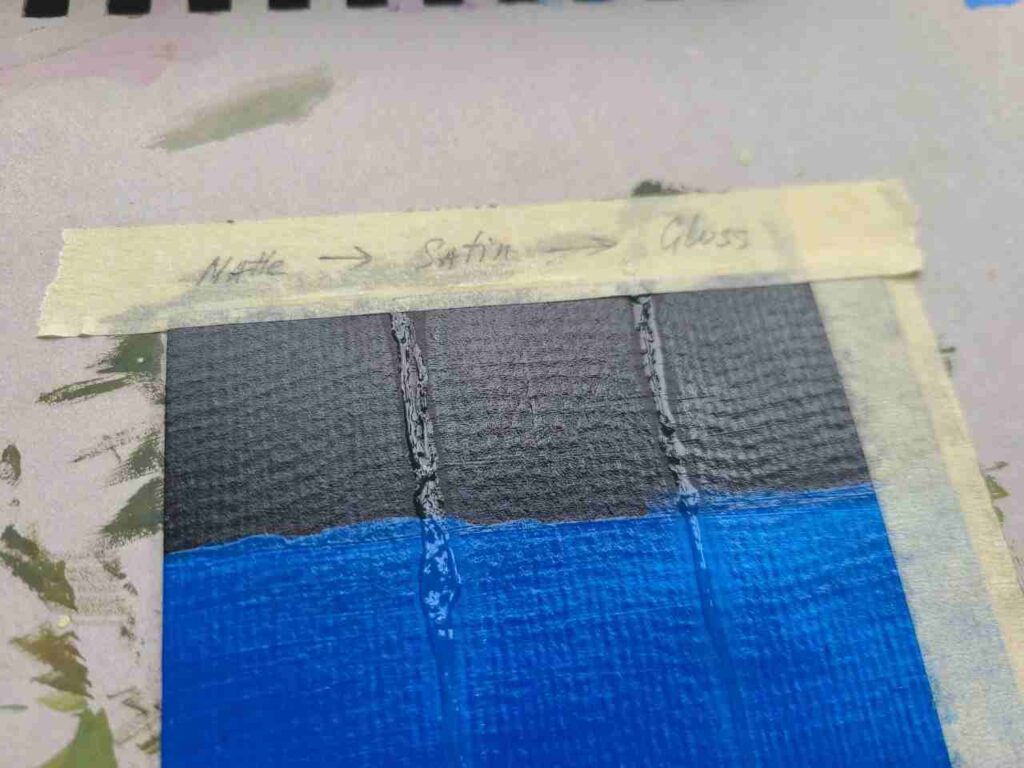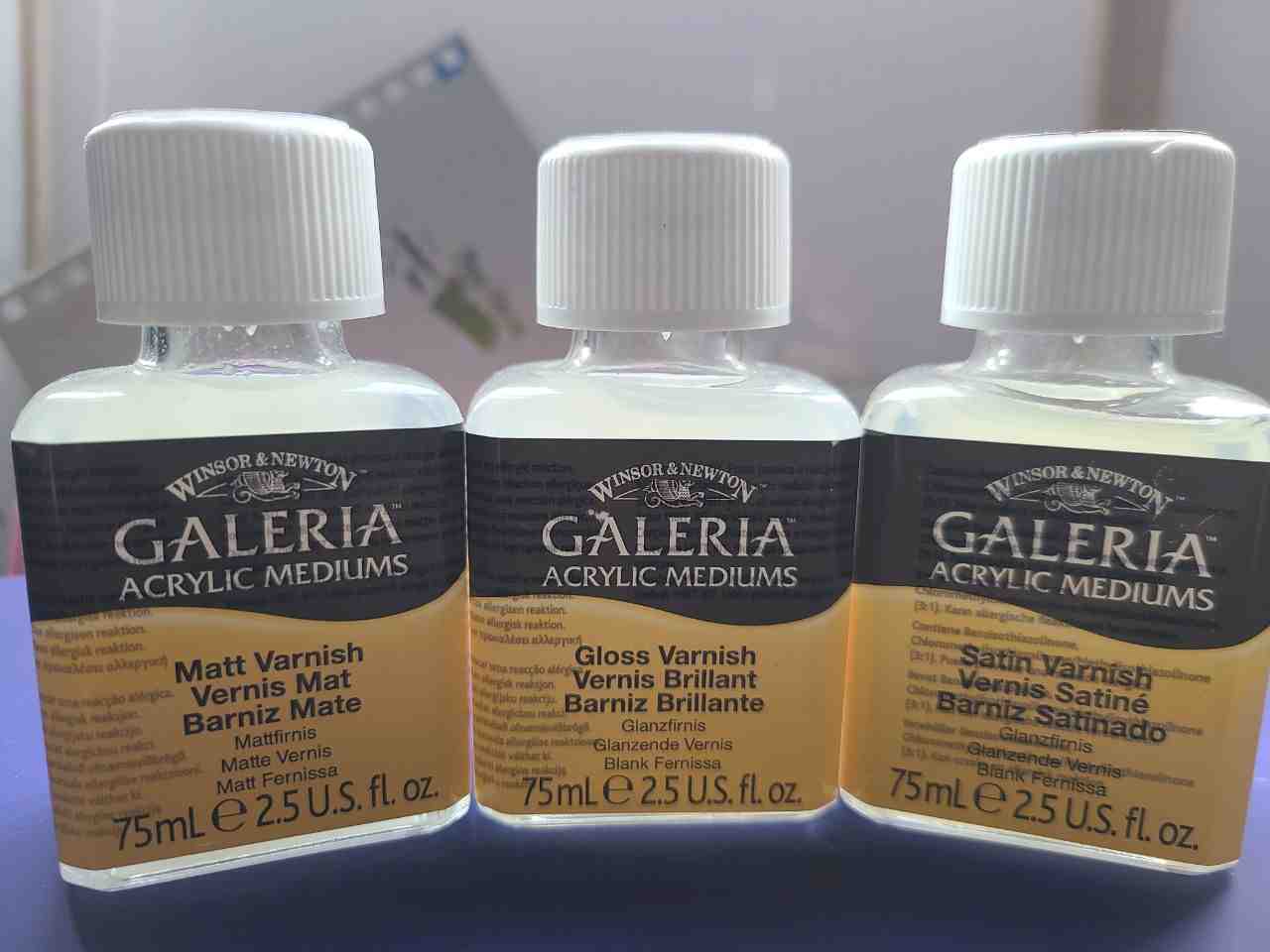Last Updated on March 20, 2024 by Masha Eretnova
To varnish my acrylic painting and pourings I use liquid and spray varnishes. I trust professional brands and they never let me down or cause any milkiness or issues to my paint.
Let me share with you what varnishes you can use for acrylic painting and how to choose the best fit for your needs.
I will show you my varnishes as well.
What type of varnish to choose For Acrylics?
Varnishes vary based on:
- removal option: removable and permanent. Do not ever use permanent.
- finish gloss, satin, matte, semi-gloss. The choice is responsible for a shiny finish or a dull one.
- composition: water-based or solvent-based.
Brr…what to choose? I choose removable gloss or satin polymer acrylic varnishes for flat paintings and spray varnishes for textured art.
Varnish can be removable and non-removable (permanent)
You need to remove and repeat varnishing every 50 years because varnish collects all dust and dirt and can become yellow over time.
If you’ve chosen permanent varnish you won’t be able to remove it and save your painting for longer years. If you still try to remove permanent varnish, you can damage your painting.
Varnish can have matte, satin, gloss, or high gloss finishes:
- Glossy varnish slightly enhances the color’s vivacity and is recommended for dark paintings (the colors will automatically pop from the canvas surface but not in a weird way)
- Satin varnish looks somehow semi-gloss, it is actually the most selling and used type of varnish finish.
- Matte varnish may make darker colors lighter.
You can choose any based on your preferences or mix them to achieve the desired effect.
If you try to apply a satin or matte varnish to a black painting, the black color will look duller. To create real dark black, use a glossy finish.
The choice of matte/gloss varnish can also rely on the lights and environment where the painting will be placed.
Remember that a glossy finish is light reflective so it can cause a glare, while a matte finish is non-reflective.

Varnish can be water or solvent-based
- The water-based varnish is an acrylic polymer. It is the best choice for beginners (and for most pros too). It protects the painting, doesn’t have a strong smell, and dries quickly. It is the best option for acrylic paintings.
The water-based varnish can be less convenient for big canvases as it dries quickly. It’s worth saying that it is a bit milky while applying but dries clearly, don’t worry!
- The solvent-based varnish or Mineral Spirit Acrylic (MSA) varnish dries harder than water-based varnish.
MSA varnishes are clear when wet, and have self-leveling qualities, it means you don’t have to worry about brush strokes. They are a little bit clearer when dried than water-based.
Solvent-based varnish needs to be thinned before using with full-strength spirits. It smells pretty strong and is not easy to clean after.
Can I use oil-based varnish over acrylic paint?
It is not recommended to use oil-based varnish over acrylic paint. Oil-based varnish can yellow, crack, and peel over time, which can affect the appearance of the acrylic paint.
Any oil-based mediums can not properly dry and stay sticky on the acrylic painting surface.
Top Choice varnishes for acrylic painting
My personal choice is Liquitex and Winsor & Newton but Golden mediums and varnishes are historically popular among the best artists of our time.
Also Golden has a mineral spirit varnish option that can work on acrylic paint with a proper isolation coat.
| Brand | Note | Price range |
| Golden Polymer Varnish | Removable water-based varnish with Ultra Violet Light Stabilizers Upd 2024: Golden has currently discontinued it | |
| Golden MSA varnish | Mineral Spirit Acrylic Varnish with UltraViolet Light Stabilizers Removable Thicker viscosity than traditional varnishes Remove with spirits Upd 2024: hard to buy, there is an issue with production | Pricey |
| Liquitex Varnish | UV protection, durable NOT removable Matte, Satin, Gloss, High Gloss * I got some testimonials about cracks and uneven coverage using Liquitex. | Affordable |
| Liquitex Soluvar | Removable solvent-based varnish for both oil and acrylic paintings Requires you to let your painting dry for up to 2 weeks before varnishing. Must have isolation coat before applying it. 1-2 coats are enough | Pricey |
| Grumbacher spray varnish | Crystal-clear when applied Dries quickly Has gloss finish Non-yellowing Removable with paint thinner or a mild solvent 11 oz | Mid-range |
| Winsor & Newton Varnish spray (I use) | I’m using this for some paintings on paper and pouring. Dries super fast, and glossy. Very convenient to use Do not alter the colors. Amazing value for money but doesn’t create a hard film. | Affordable |
| Winsor & Newton Liquid Varnish (I use) | Have 3 sheens available: from matt to glossy. Super easy to apply, has no strong odor, and is dry clear. | Affordable |
| Mod Podge ( I use it only for crafts) | Cheap craft solution for kids or fun projects you are not planning to sell | Cheap |

Another craft cheap option is Mod Podge. It is not a pro-choice and as far as I know, it is not removable but it works on pretty much any surface.
It is based on glue so that’s why it is super cheap. As you can see it is also white while wet but dries to a satin finish (I would say it has a very low sheen).
I used it on rocks, wood, and denim and it worked. But I wouldn’t use it for painting.

homemade varnish Recipe
It is not recommended but you can make a DIY, homemade varnish for acrylics with glue and water.
Most homemade recipes online work only for wood or oil-based paints.
There are a few options though:
- glue-based (closer to what Mod Podge is): mix thoroughly 1/3 water with 2/3 white glue (PVA/Elmers)
- making natural varnish – but the recipe and production are very complex. Yet, there is this 100% eco-friendly and natural varnish for sale.
- if you have any clear resins – It can also be a homemade varnish.
Some recipes call for glue mixed with glycerin for acrylic varnish but I would not do that.
Glycerin is oily and it will sit on top of the painting and won’t dry.
To Sum Up
To be clear – I do not varnish works that I’m not planning to sell or display, experiments, works in progress, and tests.
However, once I decide that the work is done, I let it dry and sit for a good week and then I take photos first, to avoid glare from glossy varnish, and then varnish.
I think, for me spray varnishes and fixatives are easier to use, as they basically do not require any preparation and you don’t need to clean the brush and the container afterward and watch out for brushes losing hair, etc.
At the same time, the horrible odor most sprays have is not cool. If I would not have outdoors area or balcony, I would never use a spray varnish.
What varnish option do you prefer and do you varnish your works at all?

Masha Eretnova, born in 1991, is a Buenos Aires-based certified teacher, artist, and member of the Professional Artist Association with 20+ years of personal painting journey.
She started painting and drawing very early and is now an international abstract artist and educator passionate about acrylic painting, gouache, and crafts.
Her works are part of international exhibitions and contests, including ArtlyMix (Brazil), Al-Tiba 9 (Spain), Exhibizone (Canada), Italy, and many more.
Besides her artistic pursuits, Masha holds a post-grad diploma in Teaching Film Photography and 2 music school diplomas: piano and opera singing.
